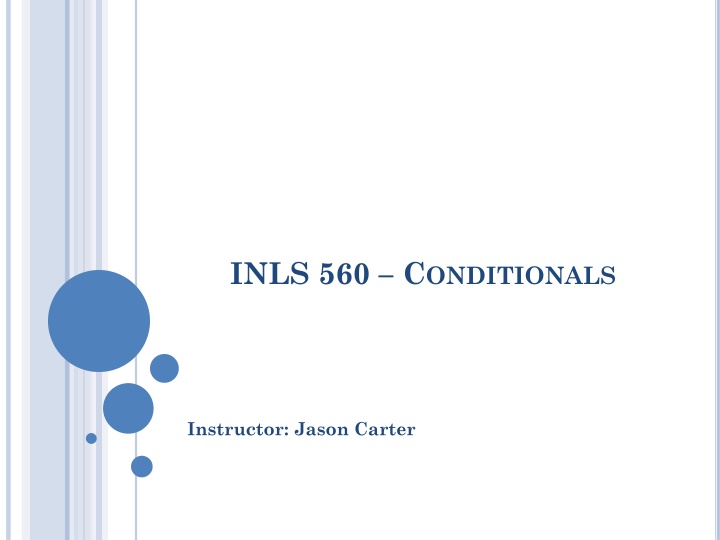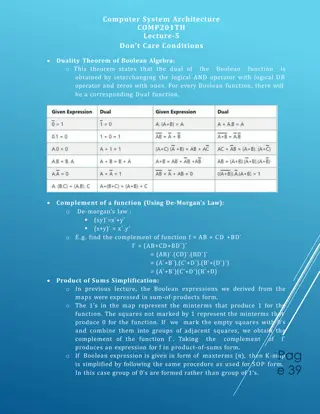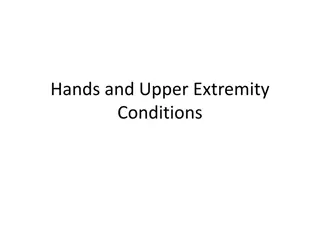
Python Conditionals and If Statements
Explore the concepts of Python conditionals and if statements through examples and explanations. Learn about boolean expressions, relational operators, and how to use decision blocks effectively in your code.
Download Presentation

Please find below an Image/Link to download the presentation.
The content on the website is provided AS IS for your information and personal use only. It may not be sold, licensed, or shared on other websites without obtaining consent from the author. If you encounter any issues during the download, it is possible that the publisher has removed the file from their server.
You are allowed to download the files provided on this website for personal or commercial use, subject to the condition that they are used lawfully. All files are the property of their respective owners.
The content on the website is provided AS IS for your information and personal use only. It may not be sold, licensed, or shared on other websites without obtaining consent from the author.
E N D
Presentation Transcript
INLS 560 CONDITIONALS Instructor: Jason Carter
CONDITIONALS What happens if secondNumber = 0? Traceback (most recent call last): File "/Users/jasocarter/PycharmProjects/Test/Test.py", line 9, in <module> quotient = firstNumber/secondNumber ZeroDivisionError: integer division or modulo by zero
THEIF STATEMENT Python syntax if condition: Statement Statement First line is known as the if clause Includes the keyword if followed by condition The condition can be true or false When the if statement executes, the condition is tested, and if it is true the block statements are executed. Otherwise, block statements are skipped
BOOLEAN EXPRESSIONSAND RELATIONAL OPERATORS Boolean expression: expression tested by if statement to determine if it is true or false Example: a > b true if a is greater than b; false otherwise Relational operator: determines whether a specific relationship exists between two values Example: greater than (>)
BOOLEAN EXPRESSIONSAND RELATIONAL OPERATORS Expression Meaning x > y Is x greater than y? x < y Is x less than y? x >= y Is x greater than or equal to y? x <= y Is x less than or equal to y? x == y Is x equal to y? x != y Is x not equal to y? == operator determines whether the two operands are equal to one another Do not confuse with assignment operator (=)
BOOLEAN EXPRESSIONSAND RELATIONAL OPERATORS Any relational operator can be used in a decision block Example: if balance == 0 Example: if payment != balance You can use if statements inside of functions Statements in inner block must be indented with respect to the outer block
COMPARING STRINGS Strings can be compared using the == and != operators String comparisons are case sensitive Strings can be compared using >, <, >=, and <= Compared character by character based on the ASCII values for each character If shorter word is substring of longer word, longer word is greater than shorter word
PRACTICE Write a program that prompts a user for his or her age and prints out whether or not they are (legally) allowed to drink alcohol. You should write 2 functions: main needs to prompt the user for their age legal needs to output if the person is of legal drinking age
Explain what the code is doing format(MIN_SALARY, ,.2f ) NESTED if-else
COMMENTS Comments: notes of explanation within a program Ignored by Python interpreter Intended for a person reading the program s code Begin with a # character End-line comment: appears at the end of a line of code Typically explains the purpose of that line
FORMATTING OUTPUT format()function Takes two arguments First argument can be string float Integer Second argument is a format spec
FORMATTING SPEC s string d integer f float %.<number of digits>f - Floating point numbers with a fixed amount of digits to the right of the dot. For each type (string, integer,float), one can specify the number of characters (strings) or digits (integer, float) to display
FORMATTING INTEGERSAND FLOATS Integer Float
NESTED DECISION STRUCTURESANDTHEIF-ELIF- ELSE STATEMENT A decision structure can be nested inside another decision structure Commonly needed in programs Example: Determine if someone qualifies for a loan, they must meet two conditions: Must earn at least $30,000/year Must have been employed for at least two years Check first condition, and if it is true, check second condition
NESTED DECISION STRUCTURESANDTHEIF-ELIF- ELSE STATEMENT Important to use proper indentation in a nested decision structure Important for Python interpreter Makes code more readable for programmer Rules for writing nested if statements: else clause should align with matching if clause Statements in each block must be consistently indented
IF-ELIF-ELSESTATEMENT if-elif-else statement: special version of a decision structure Makes logic of nested decision structures simpler to write Can include multiple elif statements Syntax: if condition1 statements elif condition2 statements else statements
LOGICAL OPERATORS Logical operators: operators that can be used to create complex Boolean expressions and operator and or operator: binary operators, connect two Boolean expressions into a compound Boolean expression not operator: unary operator, reverses the truth of its Boolean operand
THEAND OPERATOR Truth table for the and operator
THEOR OPERATOR Truth table for the or operator
SHORT-CIRCUIT EVALUATION Short circuit evaluation: deciding the value of a compound Boolean expression after evaluating only one sub expression Performed by the or If left operand is true, compound expression is true. Otherwise, evaluate right operand Performed by the and If left operand is false, compound expression is false. Otherwise, evaluate right operand
THENOT OPERATOR Takes a Boolean expression as operand and reverses its logical value Sometimes it may be necessary to place parentheses around an expression to clarify to what you are applying the not operator Truth table for the not operator
CHECKING NUMERIC RANGESWITH LOGICAL OPERATORS To determine whether a numeric value is within a specific range of values, use and Example: x >= 10 and x <= 20 To determine whether a numeric value is outside of a specific range of values, use or Example: x < 10 or x > 20
BOOLEAN VARIABLE Boolean variable: references one of two values, True or False Represented by bool data type Commonly used as flags Flag: variable that signals when some condition exists in a program Flag set to False condition does not exist Flag set to True condition exists
REVIEW QUESTIONS Does an if statement always need to be followed by an else statement? If you write an if-else statement, under what circumstances do the statements that appear after the else clause execute? Assume the variables a = 2, b = 4, c = 6. What do the following statements evaluate to (true or false)? a == 4 or b > 2 6 <= c and a > 3 1 != b and c != 3 a >= -1 or a <= b not (a > 2)
PRACTICE Write a program that asks the user when their birthday is (month and day of month as ints). Then print a message telling them if their birthday has already passed this year, is yet to come this year, or is today. You should write 2 functions: main: prompts the user for their birth month and day, calls birthdayMessage birthdayMessage: takes in the birth month and day and outputs a message about their birthday






















